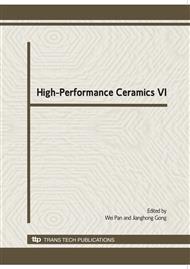p.343
p.346
p.350
p.354
p.357
p.361
p.366
p.369
p.371
Low Temperature Sintering of Ferro-Materials with Both Capacitance and Inductance Properties
Abstract:
Ferro-materials which possess both capacitance and inductance were sintered at low temperature using Bi2O3 as sintering additives. The composition of ferro-materials is 0.4PMZNT- 0.6NiCuZn. PMZNT relaxor ferroelectric is a solid solution that consists of Pb(Mg1/3Nb2/3)O3, Pb(Zn1/3Nb2/3)O3 and PbTiO3. NiCuZn ferrite with general formula is Ni0.2Cu0.2Zn0.6Fe2O4. Effects of the content of Bi2O3 and sintering temperature on the relative density of prepared ferro-materials have been studied. Dense ferro-materials were obtained at as low as 890°C with 2.0 wt% of Bi2O3. The X-ray diffractometer (XRD) identifications showed that ferro-materials consisted of distinct ferroelectric and ferromagnetic phases. Scanning electron microscopy (SEM) observations revealed that low temperature sintered ferro-materials possess high density and fine-grained microstructures. Prepared ferro-materials exhibit electromagnetic properties.
Info:
Periodical:
Pages:
357-360
Citation:
Online since:
March 2010
Authors:
Keywords:
Price:
Сopyright:
© 2010 Trans Tech Publications Ltd. All Rights Reserved
Share:
Citation:


